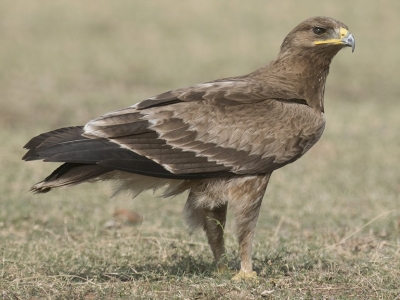
The Indian Spotted Eagle, or Clanga hastata, is a large-sized brown eagle found in the South Asian regions of India, Pakistan, Nepal, Bhutan, Myanmar and Bangladesh. It belongs to the family Accipitridae and is about 60 cm in length with a wingspan of 150 cm.
This species has a brown plumage with contrasting wing feathers and dark eyes. The wings and tail are short and the head is broader than usual. This eagle has the widest mouth of all spotted eagles. The tips of the head and neck feathers have creamy spots giving this eagle a spotted appearance; hence its name. However, not all spotted eagles exhibit these spots and each eagle has distinctive colouring making them unique. The spotted eagle has a bright yellow mouth, a black, hooked, very sharp beak and yellow legs.
They prefer subtropical to tropical forests and avoid wetland habitats. They are fairly approachable and may be seen perching in fields and urban parks. The Indian spotted eagle makes its nest in the fork of tall trees with sticks, twigs and leaves. The females are generally larger than the males and lay 1 to 2 eggs at a time. Both male and female birds take part in incubation which lasts 31 days. This raptor is a monogamous bird, which means it will have only one partner for life.
Its call is a high-pitched, shrill cackle. It is a master hunter and eats a variety of small mammals, reptiles, amphibians, small birds, insects and fish. It lives for around 12-15 years and is highly sedentary; meaning that it will not move from the area it is born in.
Its population figures are slowly declining and it is listed as vulnerable in the IUCN Red List. It faces loss of habitat due to deforestation and urbanization.
Picture Credit : Google




